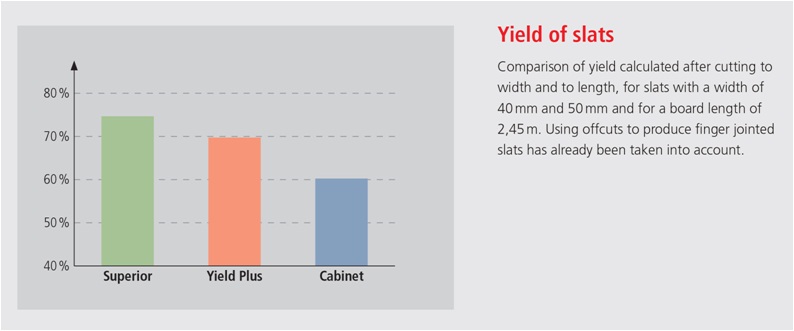 Lumber pricing is on the rise. Getting usable cuts from every cubic inch of lumber has never been more important to your profit margin.
Lumber pricing is on the rise. Getting usable cuts from every cubic inch of lumber has never been more important to your profit margin.
What is the perfect hardwood? It's one that provides higher yield, increase productivity, flexible, durable, usable and readily available, says cutting and lumber experts.
Some characteristics in lumber for getting higher yield are obvious, such as material with fewer defects. Lumber that has wider boards will also produce higher yields and better throughput, with labor savings and superior products.
 What does more productive lumber look like? As a general rule, it is:
What does more productive lumber look like? As a general rule, it is:
• Flatter
• Straighter
• More stable
• More uniform in color
How do you select the grade?
How does lumber grade affect yield? Some businesses will choose the lowest cost lumber, with a view to keeping costs down.
But a comparison of yield from a higher grade to a lower grade of lumber can vary greatly. Doug Martin, president of North American sales for Pollmeier, Inc., cites an analysis done in Europe, of three lumber grades cut to slats for width and length.
The analysis found that the highest grade lumber yielded 75% usable material with 25% waste; a medium grade yielded 70%; and a lower grade yielded just 60%.
 But the lowest cost grade in this case was not really the best value. Though lowest grade lumber cost less per foot, the higher yield of the medium grade delivered more usable product, while the lower grade lumber had more waste. The total board feet required to produce a job with the medium grade quality was the better value, delivering the same inches of usable lumber per dollar.
But the lowest cost grade in this case was not really the best value. Though lowest grade lumber cost less per foot, the higher yield of the medium grade delivered more usable product, while the lower grade lumber had more waste. The total board feet required to produce a job with the medium grade quality was the better value, delivering the same inches of usable lumber per dollar.
"With the middle grade - when you analyzed the yield and throughput costs - actually produces components that are in equal cost to the lower cost grade," says Pollmeier's Doug Martin.
 "The advantage of cutting the middle grade is longer length cutting and wider rip cutting," Martain says. "You get not only a higher yield but a higher volume of the more desired longer, wider cutting. So in choosing the right grade first analyze the cutting length and width needed."
"The advantage of cutting the middle grade is longer length cutting and wider rip cutting," Martain says. "You get not only a higher yield but a higher volume of the more desired longer, wider cutting. So in choosing the right grade first analyze the cutting length and width needed."
If the need as for wider widths and longer lengths overall - for larger components, for example - one would choose the higher grade lumber. "Manufacturers of smaller components could get away with cutting the lower grade," Martin says.
"The main thing one needs to look at after choosing the right grade and the right quality of lumber is finding the right supplier. Once you know the species cut, the region of species you are cutting and choosing the right grade, given your length and width desired needs, finding a supplier that will give you the quality of flatness, straightness, accurate tally, on-grade, is very important."
Learn more by listening in to a free webcast (originally broadcast Feb. 27, 2014), with TigerStop's Mike Anderson and Pollmeier's Doug Martin examining how to optimize yield in woodshop ripping and cross cutting. You'll hear about steps to save as much as 30% on material costs, while still getting the parts you need.






Have something to say? Share your thoughts with us in the comments below.